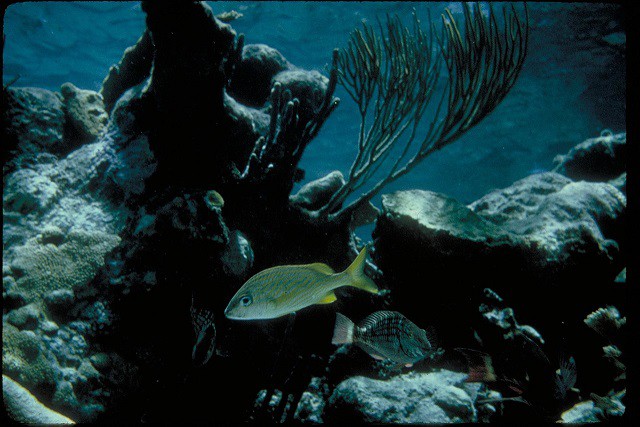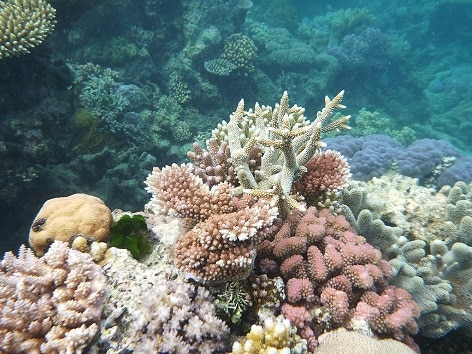| 1 | An egg-eating sea snake |

The turtle-headed sea snake (Emydocephalus annulatus) is an 80cm species which ranks as one of the more common sea snakes worldwide. This species is abundant along the north coast of Australia, around many Pacific Islands, and near the Philippines and eastern Malaysia further north. Compared to other sea snakes though, their main claim to fame is dining on caviar, and getting it for free.
The turtle-headed sea snake eats gooey fish eggs exclusively, as across their life, they never eat a single eel or fish. They find these eggs after waiting for fish to lay them in secret coral reef hollows, before sneaking in behind and greedily scooping them up.
Turtle-headed sea snakes aren’t the deepest swimming species, preferring to prowl at distances of 1-2 metres, venturing slightly deeper during summer. They’re a fairly slow-moving species, and are never found in stormy open seas, always sticking to coral reefs or bays with a coral floor. It’s even rare to find them in sandy areas between coral reefs, though it’s possible.
Turtle-headed sea snakes are encountered by mankind quite commonly, and in certain bays, they completely take over. In Noumea, New Caledonia, they made up 97% of sea snake sightings among snorkelers, as recorded over 17 years.
| 2 | Spends hours searching for eggs |
Turtle-headed sea snakes move less than 2 metres per minute while foraging. But they move consistently, grinding ever further through the coral reef chasms, patiently investigating every crack. They poke their heads into an average of 2-3 crevices per minute, flecking their tongues constantly. Their lung capacity isn’t as huge as some sea snakes (particularly the yellow-bellied sea snake), and they surface once every 30 minutes, ascending to the sea surface rapidly, poking their head above for only a few seconds, taking deep gulps of air, making a clearly audible sound. They then dive deep and instantly resume their foraging from the exact same position.
Fish eggs are gooey and stick to rocks – how is a snake supposed to swallow them? A reticulated python would fail miserably. Instead, turtle-headed sea snakes have extended scales that act as scraping tools, located on their upper lips, which they can move from side to side.
Unlike a python, Emydocephalus annulatus feeds similarly to a cow, which grazes on grass in a field for endless hours. Turtle-headed sea snakes can swallow up eggs several times per hour, as they probe cracks, preferring to have numerous small meals rather than one giant meal occasionally.
| 3 | Tracks down eggs using scent |
Snorkelling scientists headed to Baie des Citrons, New Caledonia in winter, and sacrificed 26 females and 13 males in order to analyse their stomach contents. Every snake contained thousands of fish eggs. The fish eggs they feed on average at 0.5-1mm in diameter each. This means that their prey-predator ratio is one of the most minuscule in the snake kingdom. African rock pythons can swallow impalas 120% of their own body weight, but a turtle-headed sea snake can weigh 100,000 times more than the individual fish eggs they eat, equalling 0.001%.
This study also proved that turtle-headed sea snakes hunt using scent alone. Firstly, they placed transparent vials in front of them, one containing nothing and another fish eggs. The snakes didn’t react, despite the clearly visible meal. Next they placed two cheesecloths in front of them, hiding the contents, which were 1) nothing and 2) a batch of fish eggs. As the snakes slithered past, they were immediately attracted to the cloth containing eggs, flecking their tongues enthusiastically.
Emydocephalus annulatus is particularly attracted to the eggs of smaller fishes such as damselfish, blennies and gobies. They hunt solely during daylight hours, spending night sleeping.
| 4 | Varies in appearance |

The turtle-headed sea snake is a species of 3 morphs. The first is black and white banded, with sharply contrasting shades. Rather than neat rectangles, these are squiggly wiggly bands with uneven shapes. The second morph is fully black, with no white whatsoever. The third morph is inbetween, with blurry black and white bands that contrast only faintly.
Scientists have long been obsessed with why these bands evolved, and mimicry is one reason. Emydocephalus annulatus only has a weak venom, but its neighbours such as the banded sea krait have a neurotoxic death elixir. Copying the bands of these venomous snakes tricks hungry fish and birds into staying away, particularly given that the water surface blurs things, and makes telling the difference much harder.
The black snakes lack this disguise, but they have their own advantage: detoxifying pollution. The higher melanin in their scales binds to toxins like arsenic and nickel, before removing them during routine skin sheds. A study found that black Emydocephalus annulatus are far more abundant in polluted bays, including near the French Caledonian port city of Noumea, hub of nickel production. With barrel after barrel of toxic sludge spilling into the sea, as the 21st century goes on, this could make black Emydocephalus annulatus more common in future.
| 5 | Gathers together in groups |
Turtle-headed sea snakes have one of the more complex social systems among snakes. They often gather together, with small communities visiting the same coral reefs, down to each individual member being the same. In 2005, scientists observed a coral reef head 30 metres in diameter, and found that the same 92-194 turtle-headed snakes visited it regularly. They also had a pattern in their movements. Amazingly, snakes that were captured on a coral reef one year, were often recaptured on the very same day the next year.
In 1996, snake expert Michael Guinea observed 25 turtle-headed sea snakes gathered together in an area of just 20 feet, some mating in plain sight of the rest. They’re similarly calm around people, often not reacting at distances as close as 1 metre. No deaths are known, and their venom is one of the mildest of any sea snake. The venom yield is extremely low at just 0.15mg per bite, versus over 500mg for an African gaboon adder.
| 6 | Senses rather than sees |
Turtle-headed sea snakes have very poor eyesight in their watery world, mistaking even a diver’s fin for a female. Worse, the usual pheromones dissipate in water, becoming useless. Consequently, E annulata has evolved a heightened sense of touch to compensate.
Most snakes have thousands of touch receptors on their face, but these have dramatically enlarged in turtle-headed sea snakes, another watery adaption to match their paddle-shaped tale. In a close up, this is visible in highly rounded scales on their cheeks, which are flatter in land snakes (see here). These touch receptors allow them to sense when a female is near, and they also have rostral spines on their snout, for poking a female in the back to get her excited.
Despite these adaptions, turtle-headed sea snakes still lose the females in their grasp. A study found that 20 out of 31 couples slipped apart, but the males didn’t give up there. They attempted to mate with any object in the vicinity, in a demented quest. This included butterflyfish, and particularly black sea cucumbers (very long), which one turtle-headed sea snake courted for 15 minutes before giving up.
| 7 | Rarely leaves its home reef |

Being a sea snake, you might look into the distance, see the rocks of a distant coral reef sticking up, and get a sudden longing to explore the ocean at large. This never happens with the turtle-headed sea snake, as they stick closely to one reef and rarely embark on long migrations.
The evidence came from two reefs in New Caledonia, which were easily within swimming distance of each other (1.15km apart). Turtle-headed sea snakes on each were tagged, microchipped and released to freedom. Over the next 8 years, almost all snakes were found on the reefs where they were originally caught. 817 snakes were tracked in total, with only 2 moving between the reefs.
Genetics offered clues as well; the snakes on one reef were far more closely related than snakes on the adjacent reef, with 113 snakes having their genomes mapped. Their diet is probably responsible. Being a crevice prowler that swallows fish eggs stashed away in cracks, there’s little need to venture to the open seas, compared to sea snakes which grab actual fish swimming around.
| 8 | A surprising nemesis: algae |
In the rich forest of coral reef ecosystems, the turtle-headed sea snakes have an unfortunate bedfellow: algae. They don’t suffer from the ticks and parasites of land snakes, but can gradually become covered with sea matter, according to a 2010 study. They found a pattern correlation; the more monotonous a turtle-headed sea snake, the more likely algae was to accumulate in its scales. The black and white banded ones were far cleaner.
Most importantly, the algae build up causes turtle-headed sea snakes to slow down, by up to 20%. This can be catastrophic if the hungry mouth of a shark comes looming – imperceptible losses of agility can make all the difference. However, the same study found that they mange to compensate. Snakes with more algae became timider, hiding more often in crevices within coral reefs, with the result that algae carriers had a similar survival rate overall.
The scientists also speculated that the algae could affect the snake’s oxygen intake. Turtle-headed sea snakes gather 33% of their oxygen and expel 94% of their carbon dioxide directly through water. The theory was that the snakes afflicted with algae might have to surface more often to breathe. But another possibility was that algae actually helped their oxygen intake, by photosynthesising and producing bonus molecules right next to the snakes’ absorbent scales.
| 9 | ID signs to remember |
Turtle-headed sea snakes produce live young, in batches of 2-5. Males stop feeding completely during winter, when the desperate search for females takes priority. This usually isn’t too hard given that they rarely migrate long distances.
The colour morphs make turtle-headed sea snakes difficult to recognise. However, a trick for the banded form is that their faces are usually very black, except for a horizontal white line between the two eyes, crossing where the bridge of the nose would be (if it existed). The banded form also tends to have black spots on the white scales, unlike the banded sea krait which is far “cleaner”. Again, the bands are wonkier in Emydocephalus annulatus, rather than straight and clean cut for banded sea snakes.
Turtle-headed sea snakes become darker with age. As newborns, all are black and white banded, before a portion become fully black as adults, another chunk keep the bands, and another chunk end up inbetween.
| 10 | Declining for unknown reasons |
Some snakes are threatened by prawn trawler bycatch, particularly the olive sea snake. The turtle-headed sea snake is happily immune, due to its love of sheltered coral reef wonderlands. In a survey from 1996, they only made up 2% of accidental snake catch in Australia.
That said, this snake is still declining, with the exact reason being unknown. Pollution is one theory, another is coral reef bleaching – when elevated temperatures cause coral to expel their pigment and become white and lifeless. A 2013 study near Noumea found that turtle-headed sea snakes had declined by two thirds over 7 years, with the average daily sightings falling from 6 to 2.
The same is true for Ashmore reef, a former paradise of sea snakes, with 9 different species found in 1973. Turtle-headed sea snakes were once the most abundant species, but weren’t sighted at all in 2009 and 2010, despite hardcore surveying. The only sea snake found in 2010 was the olive sea snake.
